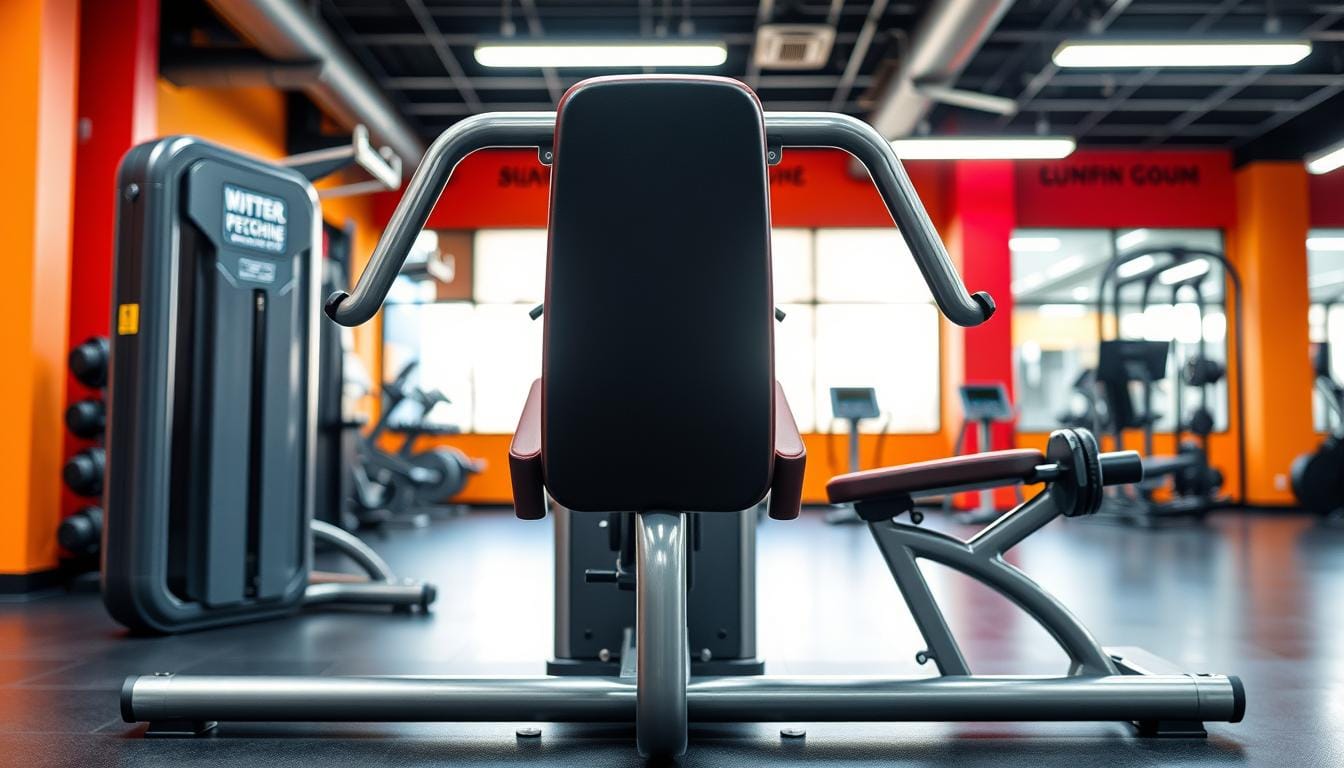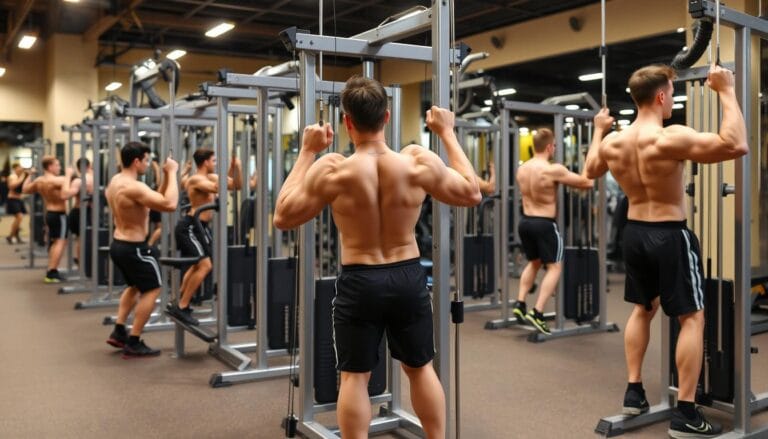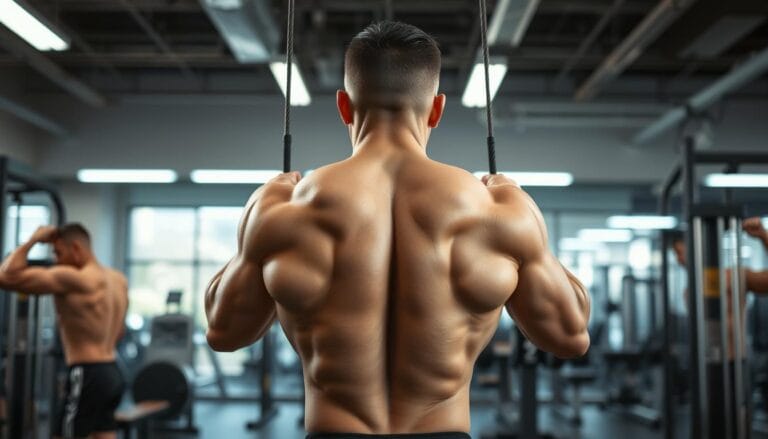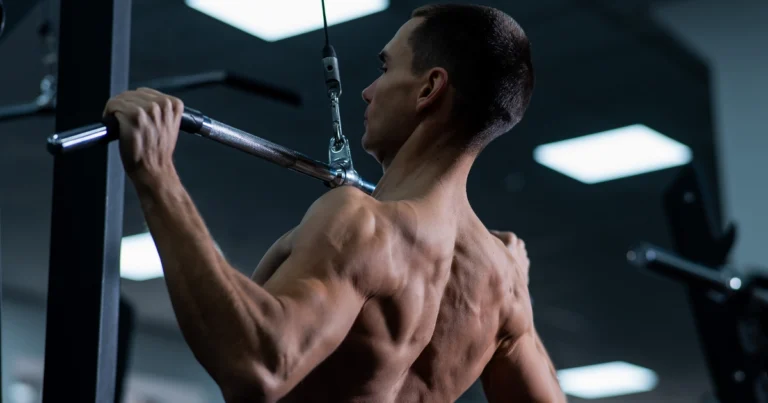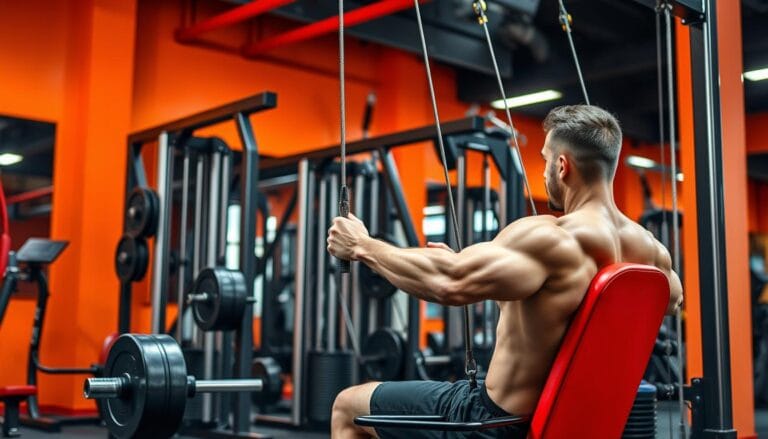Back Machine Gym Guide
Every fitness journey starts with a single step. For many, that step is building a strong back. My own journey began in a small gym with basic equipment.
Back training is more than just muscle definition. It’s about building a strong foundation for your body. A weight machine for back exercises can help you get stronger, prevent injuries, and boost your performance.
Whether you’re new to fitness or an experienced athlete, learning to use a gym back extension machine is key. Each back exercise usually involves 3 sets of 10 to 12 reps. These target muscles like the latissimus dorsi, trapezius, and lower back.
In this guide, you’ll learn from basic techniques to advanced strategies. We’ll cover different back machines, their benefits, and how to fit them into a balanced workout. This will challenge and transform your body.
Your back is more than just muscles—it’s the core of your strength. Let’s explore its full potential together.
Table of Contents
Understanding Back Muscles and Their Functions
Your back is made up of many muscles. They are key for movement, stability, and physical performance. Knowing your back muscles helps you create good low back workouts and gym exercises.
The back has several muscle groups. Each group has its own role in how your body moves and stands. Let’s look at the detailed structure of your back muscles.
Upper Back Muscle Groups
The upper back has important muscles for shoulder movement and posture:
- Trapezius: It has three parts and helps move the shoulder blade
- Rhomboids: They keep the shoulders stable and pull the scapula back
- Posterior deltoid: Helps lift the arm and rotate it outward
Middle Back Anatomy
The middle back is mainly the latissimus dorsi, the biggest muscle in the upper back. This muscle helps with pulling movements and gives the “V-taper” look.
Lower Back Structure
The lower back has the erector spinae, a group of three muscles. They are vital for keeping you upright:
- Spinalis
- Longissimus
- Iliocostalis
“Understanding your back muscles is the first step to developing an effective workout strategy.” – Fitness Expert
| Muscle Group | Primary Function | Key Exercise |
|---|---|---|
| Trapezius | Shoulder Blade Movement | Shrugs |
| Latissimus Dorsi | Pulling Movements | Pull-ups |
| Erector Spinae | Spinal Stabilization | Deadlifts |
Knowing these muscle groups helps you create better gym workouts. You can target and strengthen your entire back region more effectively.
Essential Back Machine Gym Equipment Overview
Choosing the right back machines can change your workout for the better. These machines help target your back muscles and make your workouts more effective. Knowing about different back machines is key to a solid strength training plan.
- Lat Pulldown Machine
- Seated Cable Row Machine
- T-Bar Row Machine
- Back Extension Machine
Each machine works on different back muscles, offering unique benefits. The lat pulldown machine strengthens the lats, boosting upper body strength and posture. Seated cable row machines work on the rhomboids and trapezius, making them great for a full back workout.
“The right back machines can help you build strength safely and efficiently.”
| Machine Type | Primary Muscle Group | Difficulty Level |
|---|---|---|
| Lat Pulldown | Latissimus Dorsi | Beginner to Advanced |
| Seated Cable Row | Rhomboids, Trapezius | Intermediate |
| Back Extension | Erector Spinae | Beginner |
| T-Bar Row | Middle and Lower Back | Advanced |
When picking back machines, think about your fitness level and goals. These machines offer controlled resistance. This helps you keep the right form and lowers injury risks compared to using free weights.
Lat Pulldown Machine: Technique and Benefits
Discover the power of the lat pulldown machine, a crucial piece of back exercise equipment. It can transform your upper body strength training. This versatile back training machine targets key muscle groups with precision and effectiveness.
Lat pulldowns are a fundamental exercise for developing a strong, well-defined back. The primary muscle targeted is the latissimus dorsi. This large muscle spreads across the back, creating that coveted V-shaped physique.
Proper Form and Positioning
Mastering the correct technique is crucial for maximizing your workout and preventing injury. Follow these key steps:
- Sit firmly on the machine seat
- Adjust the knee pad to secure your lower body
- Grab the bar with a grip slightly wider than shoulder-width
- Keep your chest up and back straight
- Pull the bar down to your upper chest, not behind the neck
Common Mistakes to Avoid
“Technique trumps weight every time in strength training.”
Prevent potential injuries by steering clear of these common errors:
- Using momentum instead of muscle control
- Arching your back during the movement
- Pulling the bar behind your head
- Gripping the bar too narrow or too wide
Variations and Grip Types
| Grip Type | Muscle Focus | Recommended For |
|---|---|---|
| Wide Grip | Outer Lats | Muscle Width Development |
| Close Grip | Inner Back | Bicep Engagement |
| Neutral Grip | Overall Back | Balanced Muscle Development |
Pro tip: Experiment with different grip variations to challenge your muscles and prevent workout plateaus. The lat pulldown machine offers incredible versatility for back training. It’s an essential piece of back exercise equipment in any serious strength training routine.
Cable Row Machines for Back Development
Cable row machines are great for working out your back. They offer consistent resistance that targets many muscles at once. Using them can really boost your back workout.
When you do cable rows, you work several important muscles:
- Rhomboids
- Trapezius muscles
- Latissimus dorsi
- Rear deltoids
There are different ways to do cable rows. Seated cable rows are stable, while standing ones work your core and balance.
“Proper form is the key to maximizing muscle engagement and preventing potential injuries during cable row exercises.”
Focus on smooth, controlled movements when doing cable rows. Keep your back straight, engage your core, and don’t use momentum.
| Machine Type | Primary Muscles Targeted | Recommended Sets/Reps |
|---|---|---|
| Seated Cable Row | Mid-back muscles | 3 sets of 8-12 reps |
| Standing Cable Row | Full back, core stabilizers | 3 sets of 10-15 reps |
For the best results, add cable row machines to your workout routine. Increase the weight slowly and keep the right form to keep challenging your muscles and build strength.
Back Machine Gym Workout Programs
Creating a good back machine gym workout needs careful planning. It should match your fitness level. Whether you’re new or experienced, a well-planned routine can boost strength and muscle.
Your back training will go through different levels. Each level has its own challenges and goals. It’s important to choose the right exercises and keep your technique right.
Beginner’s Routine
Beginners should start with basic exercises. These exercises help build core strength and muscle awareness. Your first program should include:
- Lat pulldown machine (3 sets of 12 reps)
- Seated cable rows (3 sets of 12 reps)
- Chest-supported row machine (2 sets of 15 reps)
Intermediate Program
As you get better, your workouts should get harder and longer. Intermediate programs add more challenging exercises:
- Wide-grip lat pulldowns (3 sets of 10 reps)
- Close-grip cable rows (3 sets of 12 reps)
- Single-arm cable rows (2 sets of 12 reps per side)
Advanced Training Split
For advanced lifters, the goal is to target muscles from different angles. This requires a detailed back machine gym plan:
| Exercise | Sets | Reps | Focus |
|---|---|---|---|
| V-bar pulldowns | 4 | 8-10 | Upper back thickness |
| Reverse-grip cable rows | 3 | 10-12 | Lower lat development |
| Face pulls | 3 | 15-20 | Rear deltoids |
Remember, progressive overload is crucial. Gradually increase weights and maintain proper form to maximize muscle growth and prevent injury.
Being consistent and patient is key. With machine gym equipment, you can build a strong, defined back.
Lower Back Strengthening Equipment
Strengthening your lower back is key to staying fit and avoiding pain. With 23% of adults worldwide dealing with back issues, finding the right equipment is vital. It’s important for anyone who cares about their health and fitness.
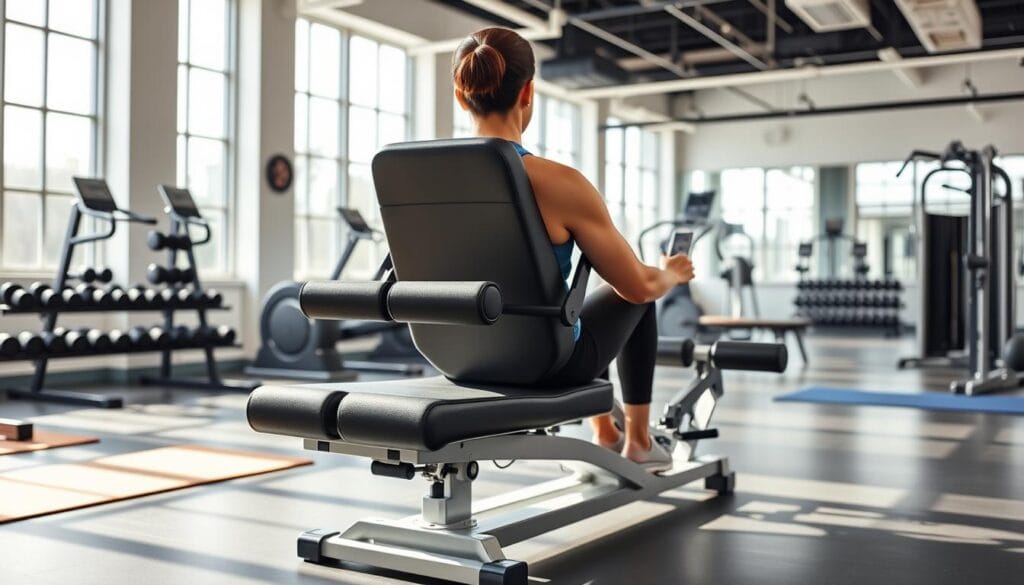
Looking into lower back exercise equipment, some machines really stand out. They are effective and target the right muscles:
- Back Extension Machine
- Roman Chair
- Reverse Hyperextension Machine
- Vibration Plate Machine
The 45-degree back extension machine is safer and allows for more movement. It focuses on the erector spinae muscles. This helps improve your lower back’s endurance and strength.
“Proper technique is paramount when using lower back strengthening equipment to prevent potential injuries and maximize muscle development.”
| Equipment | Primary Muscle Target | Effectiveness Rating |
|---|---|---|
| Back Extension Machine | Erector Spinae | High |
| Reverse Hyperextension | Lower Back Muscles | Very High |
| Vibration Plate | Stabilization Muscles | Moderate |
When strengthening your lower back, follow a 3-step plan:
- Lower Back Massage
- Lower Back Stretches
- Targeted Strengthening Exercises
Consistent training and proper form are crucial for a strong lower back. Start with light weights and slowly increase them. This helps avoid injuries.
Progressive Overload Techniques for Back Machines
To build strength in your back, you need a smart plan for progressive overload. This method helps your muscles grow and keeps your workouts exciting. It’s key when using weight machines for back exercises.
Progressive overload is a core idea in strength training. It means making your workouts harder over time. For back machines, this means tweaking your workout to push your muscles and build strength.
Weight Selection Guidelines
Picking the right weight for your back machine workouts is important. Here are some tips:
- Start with a weight that lets you do 8-12 clean reps
- When you can do all sets with perfect form, add 2-5 pounds
- Use machines that let you adjust in small 2.5-pound steps
Set and Rep Schemes
Here are some effective set and rep plans for back training with weight machines:
- Beginners: 3 sets of 10-12 reps
- Intermediate: 4 sets of 8-10 reps
- Advanced: 5 sets with varied reps (6-8 or 12-15)
“Consistency in applying progressive overload is key to long-term strength development.” – Strength Training Research Institute
Rest Period Recommendations
Rest times are crucial for muscle recovery and growth. Here’s what to keep in mind:
| Training Level | Rest Period | Purpose |
|---|---|---|
| Beginner | 90-120 seconds | Full muscle recovery |
| Intermediate | 60-90 seconds | Increased workout intensity |
| Advanced | 45-60 seconds | Maximum muscle stimulus |
Remember, progressive overload is about making small, steady increases in workout stress. Adjusting weights, sets, reps, and rest times helps keep your back muscles challenged. This promotes ongoing strength growth.
Safety Protocols and Proper Machine Setup
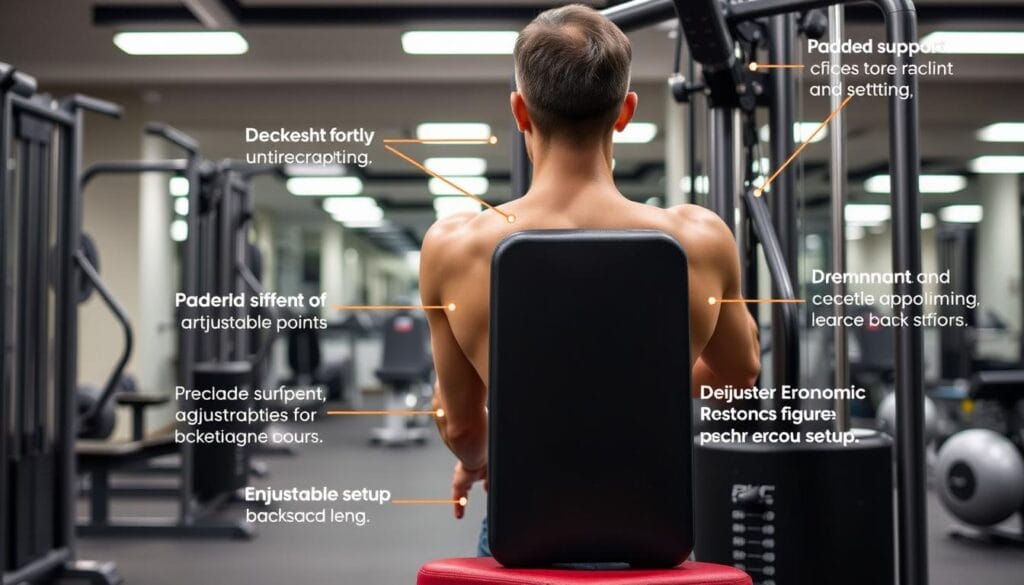
When you’re at the back machine gym, safety comes first. Knowing how to set up the machines right and follow safety rules can help avoid injuries. It also makes your workout better.
Before you start your back machine gym workout, remember these important safety steps:
- Check the equipment for any damage or wear
- Adjust the machine settings to fit your body
- Make sure the weight stack pins and safety features are working
- Clear the area around the gym back extension machine
“Safety isn’t expensive, it’s priceless” – Unknown Fitness Instructor
Setting up the machines correctly is key. Make sure the seat height, chest pad, and handle are right for you. This helps you work out your muscles better and avoid injury.
Your gym back extension machine needs special care:
- Check that the pads fit your body length
- Choose the right weight for your strength
- Move slowly and in control
- Stop right away if you feel pain
Using the equipment right can cut injury risks by up to 50%. Always focus on doing the exercises correctly, not just lifting heavy.
Don’t forget to warm up before using the machines and drink water during your workout. Talking to a fitness expert can give you tips for safe and effective training.
Combining Free Weights with Machine Training
Creating a good back workout routine needs a mix of machine and free weight training. Studies show that combining these can help build muscle better.
By mixing different types of workouts, you can grow your back muscles more. A study found that both free weights and machines helped grow muscle equally well.
Hybrid Workout Strategies
Understanding the benefits of each type of equipment is key:
- Machines offer steady resistance and lower injury risk
- Free weights work the stabilizer muscles better
- Together, they create a better environment for muscle growth
Exercise Sequencing
Here’s the best order for back exercises:
- Begin with big free weight moves
- Then do machine-based exercises
- End with specific back equipment training
Equipment Alternatives
If you can’t use certain equipment, try these:
- Use barbell rows instead of cable rows
- Try resistance bands as machine stand-ins
- Do bodyweight exercises like pull-ups
“Variety is the key to continuous muscle adaptation and growth.” – Strength Training Research Consortium
Studies show mixing free weights and machines leads to better results. The Physical Activity Guidelines say to do strength training at least two times a week for health.
Conclusion
Building a strong back needs the right back training machines. This guide shows how to pick the best equipment, like the Titan Fitness back hyperextension machine. It can change your workout for the better.
Understanding how machines work and focusing on certain muscles is key. This way, you can get stronger and look better. Machines like cable rows and lat pulldowns help you build muscle safely.
Being consistent is crucial in fitness. Using different back machines in your workouts helps you work out all your back muscles. Each machine has its own benefits for your strength and look.
Stay patient and keep improving your technique. Gradually increase the intensity of your workouts. You’ll see big changes in your back muscles.
Now you know how to create smart back workouts. Start your journey, listen to your body, and enjoy getting stronger. Back machine gym training is a rewarding path.

